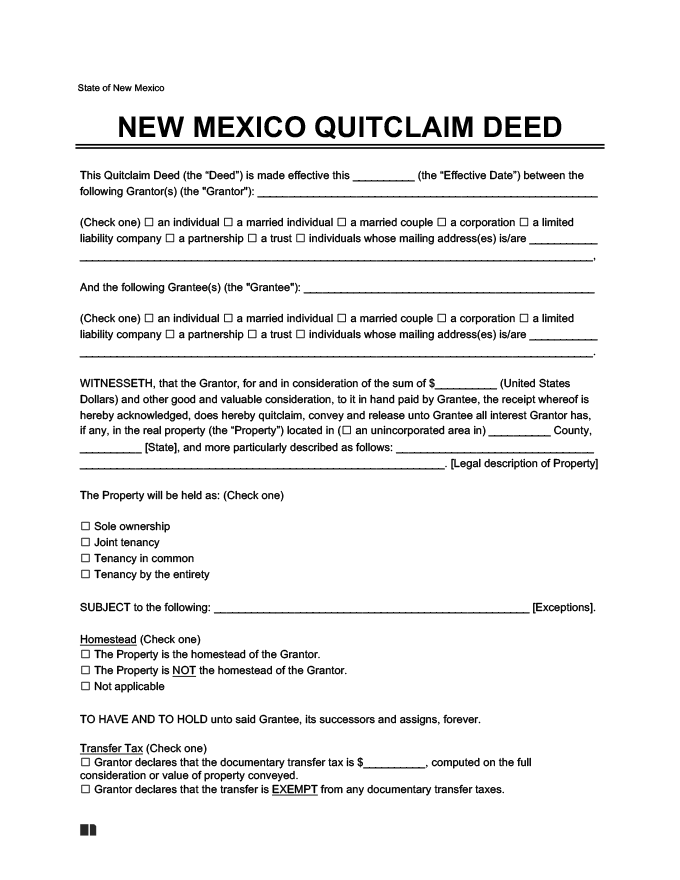In New Mexico, a quitclaim deed allows one party to quickly sign over the rights to a property to another. Quitclaim deeds do not include warranties on the property, which means that they are generally used in transactions between entities who know and trust one another.
They may be used for transactions like the transfer of real estate between parent and child or adding or subtracting someone from a title after marriage or divorce.
Legal Framework
A quitclaim deed must contain several key elements in order to be considered legal.
Statute
N.M. Stat. § 47-1-30 lays out the requirements for quitclaim deeds in New Mexico. It notes that a quitclaim deed, when executed, has the same effect as other types of deeds.
Signing the Deed
According to N.M. Stat § 47-1-44, in order to be legitimate, the quitclaim deed must be signed by the grantor in the presence of a notary and notarized.
Filing a Quitclaim Deed
Filing a quitclaim deed in New Mexico means visiting the County Clerk’s office. N. M. Stat. § 14-9-1 requires all paperwork relevant to real estate transactions to be filed with the County Clerk’s office in the county where the property is located. According to N.M. Stat. § 14-8-15, this will include a $25 filing fee.
Transfer Tax
New Mexico does not require taxes to be paid on a quitclaim deed.
Terminology
There are several key terms to take into account when arranging for a property transfer and filling out a quitclaim deed.
- Grantor: The current owner of the property, who will pass on ownership to the other party
- Grantee: The party taking possession of the property
- Legal description: A full description of the property. The legal description is not just the address of the property, but also a full description that includes its boundaries and position in the county.
Validity Requirements
There are several key elements that are necessary for a quitclaim deed to be valid in New Mexico.
- Contains all relevant information, including a legal description of the property.
- Is signed by the grantor and notarized (N.M. Stat. § 47-1-44,)
- Is filed with the County Clerk’s office (N. M. Stat. § 14-9-1)
If any of those requirements are not met, the document is not valid, which means that the grantor may retain both rights and obligations as they pertain to the property. Ensuring the validity of the document is essential for properly completing the transfer.
Content Requirements
A quitclaim deed must include essential information about the property being sold and both the grantor (the person signing over the property) and the grantee (the person taking possession of the property). It should include:
- The address of the property, including a legal description that lays out exactly where the property is located and all relevant details about it.
- The name and address of the grantor.
- The legal signature of the grantor.
- The name and address of the grantee.
- A notary’s seal, noting that the notary observed the document being signed.
Filling all these content requirements ensures that the transfer of the property will go smoothly and that the transfer will be valid.
Quitclaim Deeds vs. Other Property Transfer Methods
Choosing the right type of deed for your property transfer is essential. By choosing the right type of deed for the transfer, you can help protect both the grantor and the grantee. Furthermore, ensuring that you know what type of deed you are using will make sure the deed style chosen is the right type.
| Quitclaim Deed | A quicker and more straightforward method than many other property transfer processes, often used for adding or removing a spouse's name from property titles, transferring property between family members or close friends, and correcting title defects. It carries no warranty, meaning the grantee assumes all risks associated with the title. |
| Special Warranty Deed | This transfer method offers a warranty only for the duration the previous owner held the property, making it faster than full warranty transfers and commonly used for purchasing foreclosures and bank-owned properties. However, it may not cover the period before the current owner's possession, potentially leaving the grantee at risk for encumbrances or liens from earlier ownership. |
| Warranty Deed | This property transfer method includes a full warranty, ensuring the title is free from liens, encumbrances, or issues, offering the most comprehensive protection for the new owner. It is standard for real estate purchases but may necessitate a title search and disclosure process, potentially lengthening the transfer timeline. |
| Transfer-on-Death (TOD) Deeds | Allows ownership to pass to heirs upon the current owner's death without affecting the owner's rights during their lifetime, thus streamlining the transfer process by bypassing probate. This facilitates easier possession for heirs, avoiding the lengthy probate process. However, the current owner retains the right to revoke the TOD deed at any time before death, making the future transfer uncertain until the owner's passing. |
| Life Estate Deed | Enables a new owner to obtain property interest while the current owner retains usage rights until death, facilitating smooth transfers to heirs without probate. This method prevents the current owner from selling the property but allows them to live there, making it ideal for family arrangements. It ensures future ownership but limits the new owner's recourse against property damage, tying the new owner to the property's future with minimal interference in current usage. |
